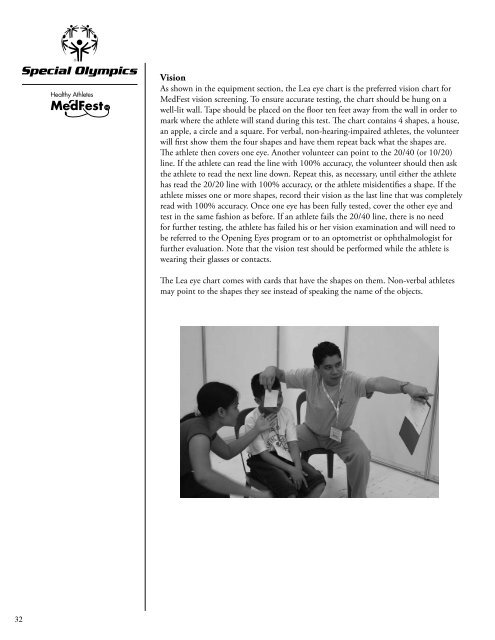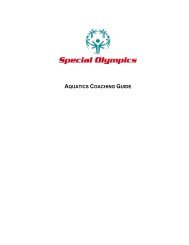MedFest Manual for Clinical Directors - Special Olympics
MedFest Manual for Clinical Directors - Special Olympics
MedFest Manual for Clinical Directors - Special Olympics
You also want an ePaper? Increase the reach of your titles
YUMPU automatically turns print PDFs into web optimized ePapers that Google loves.
32<br />
Vision<br />
As shown in the equipment section, the Lea eye chart is the preferred vision chart <strong>for</strong><br />
<strong>MedFest</strong> vision screening. To ensure accurate testing, the chart should be hung on a<br />
well-lit wall. Tape should be placed on the floor ten feet away from the wall in order to<br />
mark where the athlete will stand during this test. The chart contains 4 shapes, a house,<br />
an apple, a circle and a square. For verbal, non-hearing-impaired athletes, the volunteer<br />
will first show them the four shapes and have them repeat back what the shapes are.<br />
The athlete then covers one eye. Another volunteer can point to the 20/40 (or 10/20)<br />
line. If the athlete can read the line with 100% accuracy, the volunteer should then ask<br />
the athlete to read the next line down. Repeat this, as necessary, until either the athlete<br />
has read the 20/20 line with 100% accuracy, or the athlete misidentifies a shape. If the<br />
athlete misses one or more shapes, record their vision as the last line that was completely<br />
read with 100% accuracy. Once one eye has been fully tested, cover the other eye and<br />
test in the same fashion as be<strong>for</strong>e. If an athlete fails the 20/40 line, there is no need<br />
<strong>for</strong> further testing, the athlete has failed his or her vision examination and will need to<br />
be referred to the Opening Eyes program or to an optometrist or ophthalmologist <strong>for</strong><br />
further evaluation. Note that the vision test should be per<strong>for</strong>med while the athlete is<br />
wearing their glasses or contacts.<br />
The Lea eye chart comes with cards that have the shapes on them. Non-verbal athletes<br />
may point to the shapes they see instead of speaking the name of the objects.

















